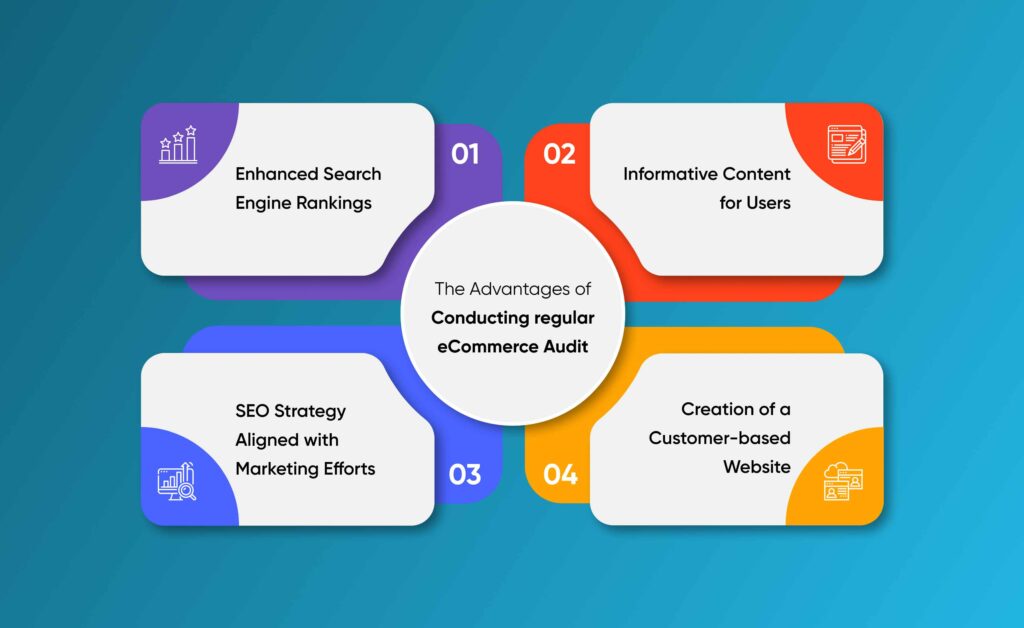
A Guide to Explain Ecommerce SEO Audit for your Online Store
Generating traffic through organic search results is a sustainable strategy for ecommerce websites. While pay-per-click ads can place your site at the top of Google search results, they can be costly in the long run. User behaviour data through ecommerce SEO audit services shows that organic search results receive more clicks than ads. To drive organic search traffic, you need to focus on ecommerce SEO audit.
This involves strategically optimising your website to rank higher in search engine results pages. Regular SEO audits are essential to assess your website’s performance and identify areas for improvement. It is important for businesses to conduct annual or semi-annual ecommerce SEO site audits.
These audits can range in cost from a few hundred to a few thousand dollars, depending on the website’s complexity and audit goals. Regular SEO audits can enhance your website’s visibility and attract the right audience to your online store.
What is an eCommerce SEO Audit?
An ecommerce SEO audit involves a thorough evaluation of an online store’s website to evaluate its search engine optimisation (SEO) performance. The purpose of conducting such audits is to identify the website’s strengths, weaknesses, and opportunities for improving its ranking on search engine results pages (SERPs).
In other simpler terms, SEO audits as a form of digital spring cleaning for ecommerce sites. It’s a great opportunity to take a more comprehensive look at a website, which is something that most business owners or site operators don’t do regularly. It’s akin to reviewing your financial statements once or twice a year.
The eCommerce SEO Audit Checklist
-
Keyword analysis
A robust keyword strategy forms the foundation of successful ecommerce SEO initiatives. It involves assessing the appropriateness and impact of the targeted keywords utilised on product pages, category pages, and across the website’s content. When selling products in a collection, it’s crucial to use descriptive language. For instance, if you’re selling red t-shirts, naming the collection ‘red’ won’t enhance your SEO. Instead, opt for ‘Red T-shirts’ to improve your visibility in search results.
-
On-page SEO and Technical SEO
The optimisation of on-page SEO elements such as title tags and meta descriptions significantly impacts webpage visibility. It’s essential to assess individual pages for optimisation, including title tags (or meta titles), meta descriptions, headers, and URL structures.
A comprehensive on-page eCommerce SEO site audit involves reviewing all product pages to optimise keyword usage and meta tags for attracting the right audience. It also includes checking for technical issues that could impact search engine crawling and indexing, such as site speed, mobile-friendliness, and URL structure. Addressing these elements, also known as off-page SEO, can help improve your ranking on search engine results pages (SERPs), even though a technical SEO audit may not directly add content to your site.
-
Content quality
Content strategy is pivotal for SEO success. It’s crucial to evaluate the quality and originality of product descriptions, blog posts, and other content on your site. The key is to understand the questions users have about your products and ensure that the information they seek is readily available on your page.
Be cautious of duplicate content spread across multiple pages, as this can confuse search engines and reduce your site’s visibility. While content across pages can be similar, it should not be identical in wording.
To clarify similar content for search engines, you can use canonical tags. These tags indicate to search engines which page should be considered the authoritative or primary version, even if other pages contain similar content.
-
Site architecture and structured data
Evaluate your site structure, including your XML sitemap and internal links, to align with search engine algorithms. If you’re using Shopify, consider SEO tools like Yoast SEO to add fields that facilitate structured data implementation.
Ensure each product includes essential information such as its name, price (with currency), estimated shipping times, and return policy. Search engine bots use this data to determine the relevance of your pages to users. Google is increasingly displaying structured data in search results, directly impacting what users see on the SERP.
-
Mobile friendliness for enhanced user experience
As the trend towards mobile commerce continues to grow, it’s crucial to optimise your online store for mobile devices. By 2025, mobile ecommerce sales are expected to reach $710.4 billion. Ensuring your site renders quickly and correctly on mobile devices is key to capturing this expanding market.
To improve your store’s mobile experience, run Google’s mobile-friendly test. This tool evaluates your site’s mobile compatibility and provides insights to enhance its performance on mobile devices
-
Internal and external links
Google and other search engines consider both internal and external links when ranking websites, making them crucial for increasing organic traffic. It’s important to analyse your site’s backlink profile to discover opportunities for acquiring high-quality, relevant links.
While external links from other websites are valuable, internal linking within your site is also beneficial. Additionally, identifying and fixing broken links, which lead to inactive pages, can improve user experience and SEO performance.
-
Conversion rate optimisation (CRO)
When evaluating your website’s conversion optimisation, it’s crucial to assess elements such as calls to action, the checkout process, and product pages. These factors directly impact how well your site can turn visitors into customers. Regarding keyword targeting, it’s essential to focus on relevant keywords that appeal directly to potential customers interested in your products. Avoid simply stuffing pages with high-volume keywords, as this won’t necessarily lead to conversions. Prioritise keywords that align with your audience’s search intent and are likely to drive actual sales.
-
Competitor analysis
During eCommerce SEO site audit, it’s beneficial to analyse the websites of your competitors to understand their strategies and tactics. This analysis can help you identify effective strategies that you can adopt for your own website. Additionally, studying competitor websites can reveal gaps in the market that you can leverage to strengthen your position within your niche.
Analysing competitors involves conducting keyword research to determine the target keywords that have been driving traffic to their sites. Additionally, assessing their website speed, searchability, and overall user experience provides valuable insights. These metrics can serve as benchmarks for your own website, helping you set goals to surpass your competitors.
-
Site security (HTTPS)
Ensure your website uses HTTPS to secure the connection between the user’s browser and the server. Google considers HTTPS a ranking factor, and having a secure site is crucial for building trust with visitors. This is especially important for ecommerce websites that handle sensitive customer data during transactions.
-
Schema mark-up implementation
Make sure schema markup is applied throughout your website, especially on product pages. Schema markup is a form of structured data, which is code that offers extra information to search engines. This helps search engines better comprehend your content by identifying details like prices, reviews, recipes, and more.
When you utilise schema markup to structure your content’s elements, these elements may appear in rich snippets at the beginning of a search engine results page (SERP). This visibility can potentially boost your click-through rates.
-
Product image optimisation
Make sure your images have descriptive file names, include relevant alt text, and are compressed for quicker loading. Optimising images not only benefits SEO but also improves the overall user experience and ensures compliance with Web Content Accessibility Guidelines (WCAG). WCAG, developed by the Web Accessibility Initiative (WAI) of the World Wide Web Consortium (W3C), aims to make websites more accessible to people with disabilities.
-
Social media integration
Evaluate the integration of your ecommerce store with social media platforms. Social signals can indirectly influence SEO, and incorporating social sharing options on product pages can enhance visibility. Ensure consistent branding across your website and social channels to create a unified experience for your customers.
A Glance at Technical SEO Audit
Technical SEO audit plays an important role in bringing success to overall SEO. Here are some pointers that brings you an insight on the same.
1) XML Sitemaps
Having a valid XML sitemap is crucial for ensuring search engines can effectively crawl and index your ecommerce site. It serves as a reference map for search engines, indicating which subdirectories and pages to crawl. To ensure your XML sitemap is effective:
- Include only the main canonical versions of your URLs without any URL parameters
- List only URLs you want indexed, ensuring they don’t have “noindex” meta tags or are blocked by robots.txt
- Set up automatic updates for your XML sitemap to reflect changes as pages are added or deleted from your site
2) Robots.txt file
The “robots.txt” file directs search engines on which parts of your site they are permitted to crawl. Ensure you have one located at “yoursite.com/robots.txt.”
If you have an active robots.txt file, check that it’s not unintentionally blocking crawlers from accessing parts of your site you want indexed. Including your sitemap location in the robots.txt file can help crawlers discover it. Add the following line at the file’s end:
“Sitemap: https://www.yoursite.com/sitemap.xml“
Ecommerce websites often have numerous pages, subdirectories, and subdomains. It’s crucial to manage your crawl budget, which is the number of pages Google crawls on your site in a set period.
During your eCommerce SEO audit service, review the “Crawl stats” in your Google Search Console. A significant difference between discovered and crawled pages may indicate you’re reaching your crawl budget limit. Use the robots.txt file to block irrelevant site parts and prioritise crawling important pages.
3) Response Codes
The next step in the technical ecommerce SEO audit involves reviewing the response codes your pages return. Ideally, most pages should return a 200 response code, indicating they are present and visible to search engines.
Address any broken pages returning a 4xx response code. If these pages are linked with misspelled URLs, correct the links. For irrelevant pages, remove any links pointing to them to prevent 4xx errors.
An increase in 5xx response codes typically indicates server issues. Ensure there are no lasting server-side problems preventing access to your site.
Lastly, 3xx response codes indicate temporary or permanent redirects. Ensure permanent (301) redirects point to the correct URLs. Avoid redirection loops (URLs redirecting to each other) and long redirect chains (crawlers redirected through multiple pages instead of directly to the correct URL).
The Advantages of Conducting regular eCommerce Audit
Enhanced Search Engine Rankings
Through an audit that identifies and addresses SEO issues, businesses can discover ways to enhance their website’s search engine rankings. By implementing these improvements, business owners can boost the visibility of their product pages and attract more organic traffic.
Enhancing your site’s performance involves optimising on-page elements, resolving technical SEO issues such as site speed and mobile friendliness, and ensuring the site aligns with search engine algorithms.
Informative Content for Users
High-quality informational content has the potential to significantly increase your website traffic. Search algorithms favour websites that offer valuable information to users. During an SEO audit, you’ll pinpoint which informational content performs best and areas where you can improve. Identifying these gaps can enhance the user experience for your customers.
While content alone may not directly lead to a high volume of product sales, prioritise informational content that highlights your products and demonstrates how they can address users’ needs. Conclude each informational piece with a compelling call-to-action (CTA) to increase the likelihood of conversion.
SEO Strategy Aligned with Marketing Efforts
An SEO audit can assist in aligning your digital marketing efforts with your website’s SEO strategy. Effective keyword usage, content optimisation, and a solid technical setup can enhance the success of other digital marketing campaigns. For instance, knowing which keywords attract users can improve the outcomes of pay-per-click (PPC) advertising, where you bid on keyword SERPs to place your ads.
Creation of a Customer-based Website
Creating a customer-based website involves designing and developing a site that prioritises the needs and preferences of the target audience. This process begins with thorough research to understand the demographics, behaviours, and preferences of potential visitors. The website’s structure, content, and features are then tailored to cater to these specific audience segments. User experience (UX) design plays a crucial role in ensuring that navigation is intuitive, information is easily accessible, and interactions are seamless. Regular feedback and usability testing help refine the website further, ensuring that it continues to meet the evolving needs of its users.
The Editor’s Note
In conclusion, conducting a comprehensive ecommerce SEO audit for your online store is crucial for achieving long-term success and staying ahead in the competitive online market. By assessing various elements such as keyword strategy, on-page SEO, technical SEO, content quality, site structure, and mobile optimisation, you can identify and rectify any issues that may be hindering your website’s performance in search engine rankings.
Additionally, focusing on link building, both internal and external, can significantly improve your site’s authority and visibility. Regular audits not only help you stay on top of your SEO game but also ensure that your website remains user-friendly and relevant to both search engines and your target audience. By implementing the findings of your audit, you can enhance your online presence, attract more organic traffic, and ultimately drive more conversions and revenue for your ecommerce business.

